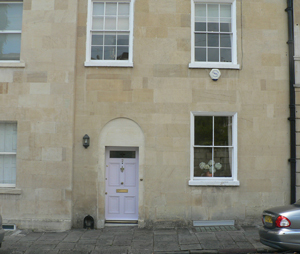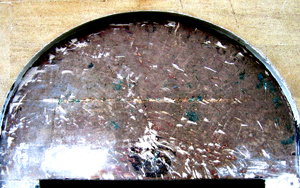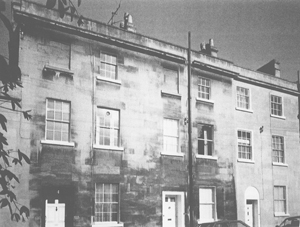No 2 Sydney Buildings

No 2 today
In June 1812 The Right Honourable William Harry, Earl of Darlington sold the land to a builder Walter Harris of Bathwick, the money being loaned by two Bath bankers.
In the Bath Directory for 1819 Walter Harris the builder lived at No1 (today’s No 2) and his son J. Harris, also a builder but a sculptor and modeller as well, lived at No 2 (today’s No 3) with Nathaniel Newport, a builder.
In July 1828 it seems that Walter Harris sold No 2 for £750.
It is not clear who bought the property but one David Jenkins of Hinton Charterhouse, named in the original purchase of land, who died in 1852, left it to James Taylor and Issac Golledge and their heirs, who held it in trust for his nephew William Jenkins until he reached age of 21.
Subsequently William’s daughter Catherine Elizabeth Jenkins, his only child, married Rev John George James M.A. D.Litt. She died a widow in April 1940 having made Lyndhurst George Groves and Sidney John Abraham her trustees and executors.
It thus appears No 2 had actually been owned by one family from the time of building for over a century the occupants initially family and later being tenants. According to the 1901 census the occupants at No 2 was a family called Hotham. [The Hotham family seems to have lived at No 2 since at least 1876; before that people called Brewer (1871 census), Dowding, McAdam (1861 census) and a Miss Ball from No 1 (1851 census)].
In February 1946 Catherine Jenkins trustees and executors Lyndhurst George Groves (solicitor in Southsea) and Richard George Schovell (funeral director and builder also of Southsea) sold it to Dr Scott-White practicing at 2 Green Park but living at the Paddock, Frome Road, Combe Down for £1,850. He also owned house in Royal Crescent. He had a tenant in the house, Miss Dorothy Dyne Muller who paid an annual rent of £750.
In June 1961 Dr Scott-White died and his wife Dorothy Wilson Scott-White inherited it. Then in August 1962 Dorothy Scott-White died. There was then a gap as their original executors had also died, but in September 1967 Eric Arthur Candy (solicitor) Arthur George Dawkins (solicitor) sold the property to Gerald Alfred White of Downside House Camerton, for £4,100.
In March 1970 Gerald Alfred White sold it to Richard Ian Harkness Baker and Rosemary Baker for £8,500 (the Halifax mortgage was £4,000).
August 1972: building was listed.
May 1975: included in conservation area.
In May 1976 the Bakers sold it to Mrs Vivienne Hazel John Sligh of Rose Cottage West Harptree for £23,000 (The British Waterways rental was then £2 pa. Bath Springs – Section 33 County of Avon Act 1982 required that any excavations or borings deeper than 5 metres may require a licence.)
In March 1985 her executors, Virginia Hazel Henshaw and David Ritchie Norris (solicitor), sold it to Terrance Edward Fitzherbert Jones and Lilian Dowie Jones, amount unknown as the price on the documents has been erased. The British Waterways rent was then £10 pa.
In July 1985 it had treatment for woodworm in the roof, rising damp chemical injection treatment, tanking and new solid floors in the basement to replace rotten wooden floors.
February 2002: owners obtained retrospective planning permission for the connecting doors at ground level and the French doors into the garden.
In October 2003 the Jones sold it to Anthony and Frances Anne White for £592,000 when the British Waterways rent was £100 pa index linked!
February 2004: planning permission for external and internal alterations including new door, damp-proofing vaults and new sash window.

'Raby Cottage' can be just seen below the line of the arch
In 2005 when the front door was stripped and repainted we found that the stone over the door had the name Raby Cottage on it. This would have fitted in with No 1 being 'Raby House'.
Extracts from the deeds by Tony White
Published June 2009
BUILDING NOTE:
"We've found a black and white photograph of house 2-3-4 dated June 1994. Nothing terribly remarkable except to show how dirty 3 & 4 were then and that the windows are now a little bit different. We also discovered that the window reveals on No 2 which are all angled unlike neighbouring houses, was a Victorian alteration."

Email from Tony White
April 2009
Sydney Buildings History Group ©
UpBack